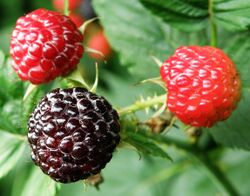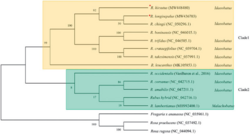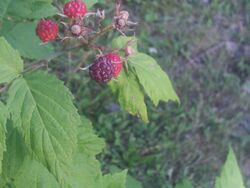Biology:Rubus occidentalis
| Rubus occidentalis | |
|---|---|

| |
| Scientific classification | |
| Kingdom: | Plantae |
| Clade: | Tracheophytes |
| Clade: | Angiosperms |
| Clade: | Eudicots |
| Clade: | Rosids |
| Order: | Rosales |
| Family: | Rosaceae |
| Genus: | Rubus |
| Species: | R. occidentalis
|
| Binomial name | |
| Rubus occidentalis L. 1753
| |
| Synonyms[1] | |
| |

Rubus occidentalis is a species of Rubus native to eastern North America. Its common name black raspberry is shared with other closely related species. Other names occasionally used include bear's eye blackberry, black cap, black cap raspberry,[3][4] and scotch cap.[5]
Description
Rubus occidentalis is a deciduous shrub growing to 2 to 3 metres (6.6 to 9.8 ft) tall.[6] The leaves are pinnate, with five leaflets on leaves, strong-growing stems in their first year, and three leaflets on leaves on flowering branchlets. The flowers are distinct in having long, slender sepals 6 to 8 millimetres (0.24 to 0.31 in) long, more than twice as long as the petals. The round-shaped fruit is a 12-to-15-millimetre (0.47 to 0.59 in) diameter aggregation of drupelets; it is edible, and has a high content of anthocyanins and ellagic acid.[7][8]
Long stems also called canes grow up to 1.8 metres (5.9 ft) in length, usually forming an arch shape, but sometimes upright. Canes have curved, sharp thorns, while immature canes are unbranched and have a whitish bloom.[9]
The black raspberry is related to the red raspberry Rubus idaeus and Rubus strigosus, sharing the white underside of leaves,[10] and fruit that readily detaches from the carpel.[9]
Habitat
The plant grows in disturbed areas, especially those that are logged or cut. It is also found in meadows, and near streams and lakes, trails or roadways.[9] The native range of Rubus occidentalis extends as far east as New Brunswick, as far west as Nebraska, as far north as Quebec, and as far south as Mississippi.[11]
Pests and diseases
Apple mosaic virus, black raspberry necrosis virus, Elsinoë veneta, raspberry bushy dwarf virus, raspberry leaf curl virus, Rhizobium radiobacter, Rhizobium rhizogenes, Didymella applanata, Monilinia fructigena, Peronospora sparsa, and Peridroma saucia all infest black raspberries.[12]
Cultivars
Common black raspberry cultivars include: Black Hawk, Bristol, Jewel, Cumberland, Morrison, Munger, and Logan.[13]
Commercial growing and processing
The center for black raspberry production is in the Willamette Valley in Oregon. The main cultivar, 'Munger', is grown on about 600 hectares (1,500 acres). Other cultivars include 'John Robertson', 'Allen', 'Jewel', 'Blackhawk', 'Macblack', 'Plum Farmer', 'Dundee', 'Hanover', and 'Huron'. The plants are summer tipped by hand, mechanically pruned in winter and then machine harvested. The yields are generally low per acre and this is why the fruits are often expensive.
The species has been used in the breeding of many Rubus hybrids; those between red and black raspberries are common under the name purple raspberries; 'Brandywine', 'Royalty', and 'Estate' are examples of purple raspberry cultivars. Wild purple raspberries have also been found in various places in northeastern North America where the two parental species co-occur and occasionally hybridize naturally.
The berries are typically dried or frozen, made into purées and juices, or processed as colorants. Fresh berries are also marketed in season. Two well-known liqueurs based predominantly on black raspberry fruit include France's Chambord Liqueur Royale de France and South Korea's various kinds of Bokbunja-ju.
A punnet of black raspberries
See also
- Dewberry, a sub-set of blackberries
- Rubus niveus and Rubus coreanus, related Asian species
References
- ↑ "Rubus occidentalis L.". Royal Botanic Gardens (Edinburgh). http://www.theplantlist.org/tpl1.1/record/rjp-102.
- ↑ Park, Young Sang; Park, Jee Young; Kang, Jung Hwa; Lee, Wan Hee; Yang, Tae-Jin (2021-04-03). "Diversity and authentication of Rubus accessions revealed by complete plastid genome and rDNA sequences". Mitochondrial DNA Part B 6 (4): 1454–1459. doi:10.1080/23802359.2021.1911712. ISSN 2380-2359. PMID 33969195. PMC 8079122. https://www.researchgate.net/publication/351016186.
- ↑ {{citation | mode = cs1 | title = Rubus occidentalis | work = Germplasm Resources Information Network (GRIN) | url = | publisher = [[Organization:Agricultural Research ServAgricultural Research Service (ARS), United States Department of Agriculture (USDA) | access-date = 2 January 2018 }}
- ↑ Michigan Bee Plants: Rubus occidentalis
- ↑ Britton, N.L.; Brown, A. 1897. An illustrated flora of the Northern United States, Canada and the British possessions from Newfoundland to the parallel of the Southern boundary of Virginia, and from the Atlantic Ocean westward to the 102d meridian. Charles Scribner's Sons, New York.
- ↑ Marrone, Teresa (2011). Indiana, Kentucky and Ohio Wild Berries & Fruits Field Guide. Teresa Marrone. pp. 262nd Page.
- ↑ Oklahoma Biological Survey: Rubus occidentalis
- ↑ Bioimages: Rubus occidentalis
- ↑ 9.0 9.1 9.2 Marrone, Teresa (2011). Indiana, Kentucky, and Ohio Wild Berries & Fruits Field Guide. Midwestern United States of America. pp. 262nd Page.
- ↑ Barotz, Sharon; Bilodeau, Carrie. "Black Raspberry". Brandeis University. http://www.bio.brandeis.edu/fieldbio/medicinal_plants/pages/Black_raspberry.html.
- ↑ "The Biota of North America Program". 2014. http://bonap.org.
- ↑ "Rubus occidentalis, black raspberry". 19 November 2019. https://www.cabi.org/isc/datasheet/48009. Retrieved 11 August 2021.
- ↑ "Raspberry varieties (includes black raspberries)". Harvest to Table. 8 November 2021. https://harvesttotable.com/raspberry_varieties_there_are/. Retrieved 11 August 2021.
External links
- Biota of North America Program 2014 county distribution map
- "Rubus occidentalis". http://www.pfaf.org/user/Plant.aspx?LatinName=Rubus+occidentalis.
Wikidata ☰ Q7376217 entry
 |




